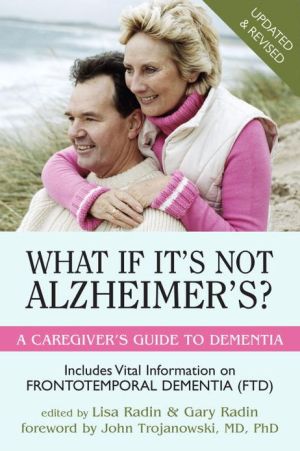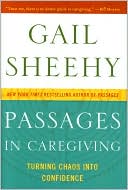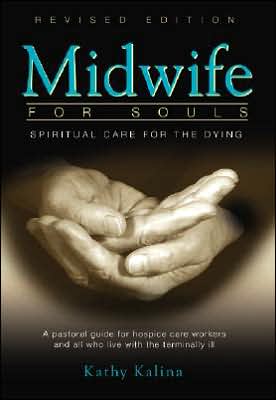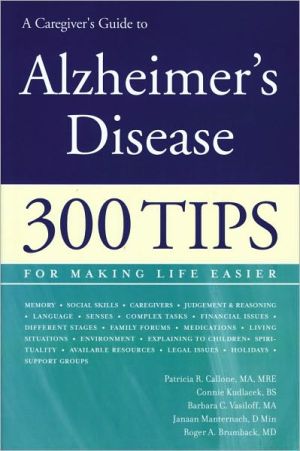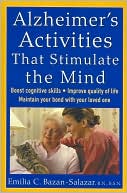What If It's Not Alzheimer's?: A Caregiver's Guide to Dementia
Although the public most often associates dementia with Alzheimer’s disease, the medical profession now distinguishes various types of "other" dementias. This book is the first comprehensive guide dealing with frontotemporal dementia (FTD), one of the largest groups of non-Alzheimer’s dementias. The contributors are either specialists in their fields or have exceptional hands-on experience with FTD sufferers.\ Beginning with a focus on the medical facts, the first part defines and explores...
Search in google:
Frontotemporal dementia (FTD) is one of the largest groups of non-Alzheimer's dementias. This guide for caregivers covers the medical aspects of FTD as well as practical issues relating to day-to-day care. Fifteen contributions from medical professionals and experienced caregivers address such topics as the stages of the disease; the benefits of speech, occupational, and physical therapies; and the ways in which FTD affects relationships with others. Several chapters are devoted to caregiver resources such as adult daycare centers and assisted living facilities. Annotation ©2004 Book News, Inc., Portland, OR
What If It's Not ALZHEIMER'S? A CAREGIVER'S GUIDE TO DEMENTIA \ Prometheus Books Copyright © 2008 Lisa Radin and Gary Radin\ All right reserved.\ ISBN: 978-1-59102-584-9 \ \ \ \ Chapter One The ABCs of Neurodegenerative Dementias \ MARTIN ROSSOR\ WHAT IS DEMENTIA?\ The most common cause of dementia is Alzheimer's disease (AD), which has dominated our thinking about neurodegenerative disorders and even determined the definition of the term "dementia" itself. It is clear, however, that there are many other causes of dementia. Before discussing these it is first necessary to consider what is meant by dementia and the history behind it.\ The term "dementia" refers to a clinical syndrome, a combination or pattern of clinical features. Thus, dementia is not a disease, but rather a syndrome that can be associated with many different underlying diseases. In this sense it is similar to heartburn or headache, which is caused by many different things and could require many different treatments. Therefore, the statement that somebody has dementia is an inadequate diagnostic formulation: One must always try to determine the cause by appropriate investigations.\ With the syndrome dementia, impairment of cognitive function is widespread. It can involve, in different combinations, memory for events; memory and understanding of facts, language, thinking, and reasoning; and perception of the world. Identifying patients with this combination of cognitive impairment was particularly important in the days before imaging (e.g., MRI and CT). It was important to distinguish patients with a localized deficit from those with more widespread problems. Cognitive function in the brain is modular and particular areas of the cerebral cortex are specialized for particular functions; for example, our ability to remember day-to-day events is critically dependant upon the hippocampus, found on the inside of the temporal lobes. (see figure 1.)\ What the Different Parts of the Brain Do\ Cerebrum: This is the term for the entire cerebral cortex (outside of the brain). The cerebrum is responsible for many aspects of thinking, including memory, problem solving, language function, personality, mood, and response to different sensory signals from the world around us. It also plays a role in movement and in feeling the senses. It is highly developed in humans, but more rudimentary in animals.\ Cerebellum: Coordinates, smoothes out, and balances movement to enable individuals to stand, walk, and use their arms.\ Frontal lobe: This part of the brain controls our ability to use words and speech (the left side) and determines how we react to situations emotionally. The frontal lobes are also important for energy, problem solving, mood, judgment, inhibiting impulses, and for individual personality.\ Parietal lobe: This part of the brain enables one to interpret sensory input such as pain, temperature differences, vibration, and touch. The right parietal lobe is also important for our sense of direction.\ Occipital lobe: This part of the brain interprets what one sees. Temporal lobes: The temporal lobes are crucial for formation of new memories (remembering). This part of the brain is always involved in Alzheimer's disease and may be involved in frontotemporal dementia. The left temporal lobe is also important for understanding what we hear.\ Brain stem: Connects the brain with the spinal cord. Without the brainstem we wouldn't be able to move or feel anything. This area is also important for automatic reflexes such as breathing.\ By contrast, our language functions are critically dependant on areas of the left frontal and temporal cortex in right-handed people. Patients with a discrete abnormality, such as a loss of language or dysphasia, by implication would have a focal or localized damage to the cerebral cortex. If this were of sudden onset it would likely be a stroke, but if it were of slow onset then it would likely be a tumor and thus require invasive and potentially dangerous investigation and surgery. On the other hand, a patient with widespread deficits would likely have a disease more diffusely affecting the cerebral cortex, such as Alzheimer's disease, and further investigation could be avoided. Historically the terms "senile" and "presenile dementia" were used merely to refer to dementias coming on late or early in life. These were most likely to be Alzheimer's disease, but again this was not a specific diagnosis as such.\ More recently the definition of dementia has been made more precise. The necessity for more than one cognitive domain to be involved remains critical to the definition; however, memory, and particularly our ability to remember day-to-day events (episodic memory), has to be affected for dementia to occur. Alzheimer's disease, in which episodic memory is the most salient deficit, is the most common dementia disorder. In addition to memory impairment, there has to be at least one other domain of cognitive impairment such as language, thinking, or perception. Furthermore, the cognitive impairment has to be significant enough to interfere with social or employment functions. In other words, the patient must be quite severely affected.\ The different degenerative diseases that can cause the dementia syndrome tend to affect different areas of the cerebral cortex. Since different areas of the cortex are specialized for different functions, the disease will tend to have characteristic patterns of deficit. This is most apparent early in the disease. As the disease progresses they tend to become more similar as dysfunction becomes more severe and more widespread. Clearly, as we move toward earlier diagnosis, essential to successful management of these diseases in the future, we will attempt to diagnose them before a patient fulfills the criteria for dementia. For example, a patient with early Alzheimer's disease may present with mild memory deficit, but this alone is not sufficient to fulfill the criteria for dementia. Similarly, many patients with a frontotemporal dementia may have preserved memory early in the disease but demonstrate quite profound behavioral and personality changes. For these reasons, many specialists now believe we should begin to move away from the term "dementia" and to speak in terms of specific patterns of cognitive impairment and the relationship to presumed underlying diseases.\ FRONTOTEMPORAL DEMENTIA\ The frontotemporal dementias (FTD) comprise the main topic of this book, and the clinical and pathological details are discussed in the following chapters. However, the key feature of this group of disorders is the involvement of a variety of disease processes of the frontal lobes and the front part of the temporal lobes of the brain. It is this characteristic distribution or topography of the degenerative process that determines the clinical features of early personality change, language, and speech impairment. There are many different underlying diseases that can present as a frontotemporal dementia. Some of these are quite specific, such as Pick's disease. Pick's disease was identified even earlier than Alzheimer's disease. Arnold Pick in Prague described two patients with prominent behavioral and language impairment. Intriguingly it was Alzheimer who again applied his expertise with the microscope to the examination of the brain and demonstrated some abnormal inclusions subsequently referred to as Pick bodies. These are now known to be deposits of tau protein. The tau protein that is deposited in Pick's disease is the same as that found in the neurofibrillary tangles of Alzheimer's disease, but is deposited in a different way. Senile plaques are not a feature of Pick's disease.\ The term "Pick's disease" has been somewhat confusing, since it has been used both as a general clinical term, essentially the same as frontotemporal dementia, as well as a very specific pathological disease. Increasingly it is used in the latter sense.\ Corticobasal degeneration (CBD) is another disease of abnormal tau. Typically it affects the parietal lobe and causes major difficulty with motor skills but can affect the frontal and temporal lobes, causing FTD.\ Some cases of FTD show abnormalities under the microscope that are similar to those found in another degenerative disorder, motor neuron disease or Lou Gehrig's disease, also known as ALS. Other patients may show no specific features when the brain is examined under the microscope and it is probable that this is a very heterogeneous group that we will gradually understand better over time.\ It is the early behavioral and personality changes and/or changes in language and speech that define this group of patients. Their memory for day-to-day events may be strikingly preserved when compared with Alzheimer's disease, and they very rarely if ever get lost until late in the disease. Three prototypic clinical syndromes have been described in association with FTD: a frontal dysexecutive syndrome, progressive nonfluent aphasia, and semantic dementia. The frontal syndrome is characterized by behavioral abnormalities. Patients become socially disinhibited, with some becoming aggressive and others apathetic. There may be changes in eating and sexual behavior. The term "frontotemporal dementia" is sometimes confined to this group. Progressive nonfluent aphasia refers to patients with speech production difficulties. Early on, they have excellent comprehension and may write well despite speaking with difficulty. As the disease progresses they become mute. Semantic dementia refers to patients with impairment of semantic memory. This term refers to our knowledge of meaning. Verbal semantic memory is our memory for the meaning of words and visual semantic memory is our memory for the meaning of objects that we see. Semantic memory contrasts with our memory for day-to-day events, referred to as episodic memory. Patients with semantic memory speak fluently but it is empty of meaning and they have major difficulty understanding. With this condition there is loss of tissue in the temporal lobes.\ DEMENTIA WITH LEWY BODIES\ Dementia with Lewy bodies (DLB) has been increasingly identified as an important cause of dementia in the elderly. In some studies it is believed to be the cause of dementia in up to 20 percent of the patients in this age group. Under the microscope, the brains of people with DLB show the senile plaques of Alzheimer's disease but far fewer neurofibrillary tangles. By contrast, they show the brain cell changes that are normally associated with Parkinson's disease, that is, a protein deposit referred to as a Lewy body, named after its original discoverer.\ Patients with DLB more closely resemble patients with Alzheimer's disease than those with FTD. There is a characteristic clinical triad that favors the diagnosis, namely fluctuation in the cognitive impairment, hallucinations, and Parkinsonian syndrome.\ The fluctuations in cognitive impairment can be quite dramatic and last from minutes to days. In between times the family will often feel that the patient is normal, at least early in the disease. The hallucinations are very frequent and patients rapidly regain insight. They are normally of people and animals. The people may often be familiar to them and distressingly may be deceased relatives or friends. The hallucinations are rarely threatening and rarely speak to the patients. They commonly accompany misidentifications of objects in their environments. For example, an abnormally hanging curtain may be seen as a figure that then takes the form of a more definite hallucination.\ The Parkinsonian syndrome is very similar to that seen in patients with classical Parkinson's disease. There is a gradual slowing of movement and of rigidity, but the tremor or shakiness of classical Parkinson's disease is less often seen.\ ALZHEIMER'S DISEASE\ It is often claimed that there is an epidemic of Alzheimer's disease. The disease has always been with us, but since it is a disease of old age, the numbers of cases have increased with the aging of the population. The real increase, however, has been due to current diagnosis, whereas thirty years ago many patients would simply have been diagnosed as suffering from senile dementia.\ Alzheimer's original case was a lady of only fifty-one years of age who presented with dementia. Alzheimer examined her brain after death using the newly available silver stains. He was thus able to demonstrate the two characteristic microscopic features: senile plaques and neurofibrillary tangles. Senile plaques are now known to reflect deposits of an abnormal protein, beta-amyloid, within the brain but not within the neurons or brain cells themselves; this is thought to be a key event in the causation of the disease. Neurofibrillary tangles are now known to be abnormal deposits of another protein within the cell itself. This protein is tau, the microtubule-associated protein. Microtubules are the building blocks of the internal skeleton of brain cells and essential to maintain the integrity of the extensive and complex wiring within the brain. If tau loses its function then microtubules become unstable, and one can see the collapse of the cytoskeleton as neurofibrillary tangles.\ Since Alzheimer's first case was a middle-aged lady it was assumed that this was a rare early onset or presenile dementia. However, studies in the United Kingdom in the 1960s demonstrated that the majority of elderly patients with dementia, which had previously been called senile dementia, were in fact suffering from Alzheimer's disease.\ The key clinical feature of Alzheimer's disease is an early impairment of episodic memory, our memory for day-to-day events. Patients may have difficulty recalling what has happened to them; they forget to do things; they may misplace items; they repetitively question; and as the disease progresses, they may get lost. We all experience these features from time to time but it is the inexorable progression that identifies the patient with early Alzheimer's disease. After a period of a few years, other features supervene with increasing difficulties with language and perception of the world. This pattern reflects the early involvement of the hippocampus, as explained previously, and other parts of the temporal lobe by the disease process.\ VASCULAR DEMENTIA\ It used to be thought that impairment of blood supply to the brain was the main cause of dementia. It was believed that hardening of the arteries, or atherosclerosis, led to a reduced blood flow. This has been disproved. While blood flow may be reduced in dementia, this is a consequence of the nerve cell loss rather than a cause. What can cause dementia is recurrent large or small strokes and nerve cell damage from disease in the small arteries to the central parts of the brain, called small vessel disease or Binswanger's disease.\ Patients with strokes can have significant problems with cognitive impairment, such as a patient with a right-sided paralysis accompanying loss of language or dysphasia. Multiple strokes can give rise to widespread cognitive impairment, but due to motor abnormalities, it is usually obvious that these are strokes and such patients rarely come to attention because of the cognitive impairment alone. Occasionally, a stroke in particular areas of the cerebral cortex or in the center of the brain (in the thalamus), can result in quite widespread cognitive impairment.\ Much more common are the consequences of high blood pressure, smoking, and diabetes in patients with dementia. These conspire to cause thickening and damage to the very small arteries that supply the center of the brain with oxygen and result in little ministrokes or lacunas together withmore diffuse damage to the central whitematter of the brain. These patients often present with cognitive impairment or dementia. They tend to be characterized by cognitive slowing and often have problems with recall but not with recognition memory. Gait disturbance, which can resemble Parkinson's disease with shuffling, is quite common. This is an important group of patients to identify. Careful management of risk factors such as blood pressure, cholesterol, and blood sugar are important and may slow progress. In addition, many patients with Alzheimer's disease have coincidental vascular disease and it is believed that the vascular disease may exacerbate the Alzheimer pathology changes.\ (Continues...)\ \ \ \ Excerpted from What If It's Not ALZHEIMER'S? Copyright © 2008 by Lisa Radin and Gary Radin. Excerpted by permission.\ All rights reserved. No part of this excerpt may be reproduced or reprinted without permission in writing from the publisher.\ Excerpts are provided by Dial-A-Book Inc. solely for the personal use of visitors to this web site.\
Foreword John Q. Trojanowski, M.D., Ph.D. 15Preface Helen-Ann Comstock 17Acknowledgments 19Introduction Lisa Radin Gary Radin 21Editors' Note 25A Medical FocusThe ABCs of Neurodegenerative Dementias Martin Rossor, M.A., M.D., F.R.C.P. 29What Is Dementia? 29Frontotemporal Dementia 32Dementia with Lewy Bodies 34Alzheimer's Disease 35Vascular Dementia 36Other Degenerative Diseases 37Other Causes of Dementia 37Investigations 38What Is Frontotemporal Dementia? A Clinical Perspective Murray Grossman, M.D., Ed.D. 41Introduction 41Clinical Presentation 42Medical Investigations 50Treatment and Management 52Summary 53The Role of Genetics: A Piece in the FTD Puzzle Jennifer M. Farmer, S.S., C.G.C. Elisabeth McCarty-Wood, M.S. 55Obtaining a Family Medical History 56Introduction to Genetics and Inheritance 58Genetics ofFTD 61Genetic Counseling and Genetic Testing 65Discussing Genetic Issues with Your Family 67Conclusion 69Finding the "A" Team: Creating a Collaboration of Health Professionals Carol F. Lippa, M.D. 71Seeking Out a Qualified Specialist 71Preparing to Visit the Doctor 73The Doctor's Examination 74Follow-Up after Visiting the Doctor 75Summary 76Therapeutic Interventions: Therapy and Nonmedical Options Richard J. Caselli, M.D. Roy Yaari, M.D., M.A.S. Lauren MacLennan, M.S.N., C.R.N.P. 77Goals of Therapy 77Pharmacotherapy 77Prevention 78Intellectual Decline 78Behavioral Problems 80Sleep Disorders 82Associated Problems 83Abrupt Decline 84Lifestyle Changes 85Nonmedical Interventions 86Rehabilitation Interventions: Uses and Benefits of Speech, Occupational, and Physical Therapies Keith M. Robinson, M.D. 97The Idea behind Rehabilitation 97The Essential Tools of Rehabilitation 99Specific Treatment Approaches 101Creating a Safe Environment 108Mobility (Gait and Balance) Training and Durable Medical Equipment (DME) 108Activities of Daily Living (ADL) Training 112Aspiration Prevention during Eating and Swallowing 113The Decision to Stop Driving 114As the Symptoms Progress: Understanding the Stages of the Disease Carol F. Lippa, M.D. 123Rate of Disease Progression 123What to Expect Over Time 125Influencing Disease Progression 126An Immortal Legacy: How Donation of Human Tissues Impacts Research and Drives Advances in Diagnosis and Therapy Jennifer M. Farmer, M.S., C.G.C. Elisabeth McCarty-Wood, M.S. Virginia M.-Y. Lee, Ph.D. John Q. Trojanowski, M.D., Ph.D. 129The Importance of an Autopsy 129A Brief History of Autopsy 131The Autopsy Process 132Research on Human Tissues and Bodily Fluids 136Impact of Biomedical and Autopsy Research on FTD 137Conclusion 140Searching for the Answers: The Future of Research and Clinical Care Jordan Grafman, Ph.D. 145Managing Daily CareSelf-Expression and Safe Eating: Understanding Speech, Swallowing, and Nutrition Erica Wollman, M.Ed., C.C.C.-S.L.P. 153Communication 153Stages of Questions 154Levels of Questioning 155Understanding Swallowing 156Administering Medications 159Need a Speech Pathologist? 160A Feeding Tube for Nutrition and Hydration 161Summary 162A Step Ahead: Exercise and Mobility Heather J. Cianci, P.T., M.S., G.C.S 165What Is Physical Therapy? 165Receiving Physical Therapy 166Dealing with Your Health Insurance Provider 166Finding the Right Therapist 167The Physical Therapy Program 168Preventing Falls 173Summary 173Challenging the Mind: Activities and Socialization Lisa Ann Fagan, M.S., O.T.R./L. 175Introduction 175Independence Issues 176The Just-Right Challenge- Modifying Activities for Success 176Specific Types of Activities 177Exercise 181Freedom and Safety 182Driving 182Summary 183Fostering Personal Care: Hygiene, Dressing, and Eating Lisa Ann Fagan, M.S., O.T.R./L. 187Factors Affecting Ability to Participate in Personal Care 188Strategies to Assist Individuals with Personal Care Tasks 189Hygiene (Grooming, Toileting, and Bathing) 189Dressing 193Eating 194Safety 195Assisting with Transfers 196Summary 197Within These Walls: Creating a Safe and Supportive Environment Lisa Ann Fagan, M.S., O.T.R./L. 199Creating a Calm and Reassuring Environment 200Creating a Safe Environment 202Falling Hazards 204Creating Environments That Maximize Functional Skills 205Technology and Home Environments 206Household Checklist 207Altered Relationships: Adapting to Emotions and Behavior Katherine P. Rankin, Ph.D. 211Introduction 211Insight and Awareness 213Loss of Empathy 215Apathy 218Rigid, Bizarre, and Socially Inappropriate Behavior 220A Balance of Health: Maintaining General Medical Care Practices Bruce L. Miller, M.D. Rosalie Gearhart, R.N., M.S., C.S. 225Patients' Rights 226Ethical Principles 227Caregiver Roles in Health Decisions 228Anticipating Health Care Decisions through the Course of the Disease 229Summary 234Final Choices: Coping with End-of-Life Concerns Jeannette Castellane, L.S.W. 235Institutional versus Home Care 235Hospice Care 239Ethics 241Final Choices 244Caregiver ResourcesProfessional Caregiving: Using Health Community Services Judith L. Fisher, R.N., M.S., Ph.D. candidate Susan Riley, M.S.W., L.S.W. 251Home Health Care 251Adult Daycare Centers 255Funding Sources for Services 256Home Away from Home: Nursing Home and Assisted-Living Options Morris J. Kaplan, Esq., N.H.A. 259When a Nursing Home Is Necessary; Finding a Good One 259Key Determining Factors 260Sources of Information 262Visiting Homes in Person 266Nursing Home Best Care Practices 267Assisted Living 272By the Hands of Others: Creating Helpful Support Networks Helen-Ann Comstock 277Setting Up a Support Network 277Resources 282Money Matters: Securing Financial and Legal Readiness Paul L. Feldman, Esq. Kent S. Jamison, Ph.D. 289Introduction 289General Resources 290Surrogate Decision Making 291Voluntary Arrangements 292Involuntary Arrangements 295Issues Affecting Income 296Covering the Cost of Medical Care 299Caregiver-Related Issues 302Covering the Cost of Institutional Care 304Other Options 308Conclusion 309Caring for YourselfA Daily Break: Respite and Personal Care for the Caregiver Vivian E. Greenberg, A.C.S.W., L.C.S.W. 313Understanding Caregiving 313What Is Respite? 315Knowing When You Need Respite 317From Loss to Life: Managing Emotions and Grief Rev. David Cotton 319Loss along the Way 319Owning Your Grief 321Four Steps to Emotional Health 325Seeing the Whole 330Contributing Authors 331About the Editors 339Resources 341Suggested Reading 349Index 353
